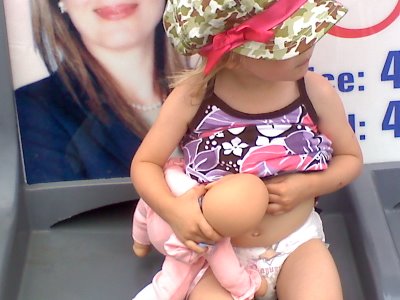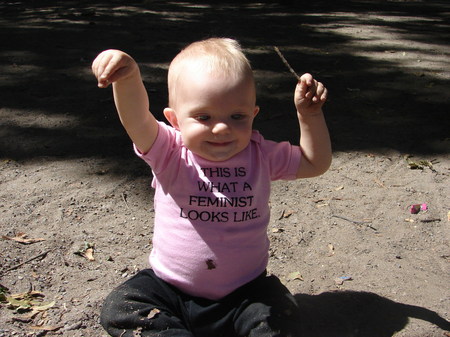Emilia isn’t one for dolls, really. She much prefers taking them apart and incorporating them into art installations than she does cuddling them and pretending that they’re real. Because they’re not real, as she likes to remind me whenever I suggest that perhaps Shoggy or Zoe or Dora might like to get to bed at a reasonable hour in her company. ‘They don’t sleep, Mommy, because they’re not real,’ she informs me with a barely contained huff of impatience, my ignorance on all things doll-related clearly a pain to her. ‘They don’t do anything real, unless I make them do it.’
Which, too right. And interesting, given the recent minor hub-bub about a doll that breastfeeds, because for all of Emilia’s disavowals of what dolls can and can not be made to do, she’s always been emphatic that when pretending to feed a baby doll, one must pretend to nurse it, because that is the closest approximation of what is really done with real babies. Emilia is right: make-believe is at its best when it mimics something of the real, and many – most? – real moms breastfeed their babies for some amount of time, so why shouldn’t there be ‘hungry baby’ – my preferred translation of the Spanish Bebe Gloton, the name attached to this particular product – dolly that is marketed as a nursing baby, rather than a bottle-fed baby?
Two objections (discounting those objections that reduce to ‘eww, breastfeeding,’ because, seriously) have been raised in online discussions about Hungry Baby: that the nursing bib/halter-thingy that seems meant to shield girlish chests from pretend-nursing is weird and creepy, and that a doll marketed as a ‘nursing’ doll is unnecessary, because children can pretend to nurse any old doll, regardless of whether that doll comes with a bottle or a nursing bib. The first point is well-taken: the bib/halter thingy is creepy and unnecessary. But it’s an easy thing to remedy: you don’t like the bib? Toss it. It’s not a reason to dismiss the product entirely. The second point has a point, but it also misses the point: marketing dolls as nursing dolls is necessary, I would argue, because it counters the dominance of dollies-with-bottles. Children can pretend to breastfeed any old doll, but they don’t, and they don’t, arguably, because pretty much all of those dolls come with what are more or less express instructions to bottle feed this baby, dammit.
Not that there’s anything wrong with a child pretending to bottle feed a doll, or that there’s anything wrong with bottle-feeding in general. But if you wander into the baby doll section of any Toys-r-Us, you’ll see every aspect of pretend-motherhood represented except for breastfeeding. Every baby doll with accessories comes with a bottle. Every one. Which teaches our children what, exactly? That bottle-feeding is the maternal norm, which implies by exception that breastfeeding is not the norm – or that if it is the norm, it is a norm that should not be emulated. That’s why marketing dolls as breastfeeding dolls can be a good thing – it counters the marketing of bottle-toting dolls. It advertises an alternative. It normalizes the alternative.
Granted, Emilia came to her own conclusions about dolls and bottles – her limited experimentation with playing with baby dolls included breastfeeding those dolls (publicly, no less.) So perhaps she’s evidence that the examples lining the toy store shelves are no match for the example set at home. But the battle for the social acceptance of breastfeeding is not a battle that is fought primarily in the home – it’s a public battle, about public ideas and public biases and public neuroses. And the marketing of toys and selling of toys are public practices that inculcate ideas about what should or should not be public. Breastfeeding should be publicly accepted and encouraged; by encouraging children to incorporate it into play, we promote that acceptance, and so extend the domain of the practice of nursing.

And that, my friends, is all win.

